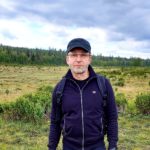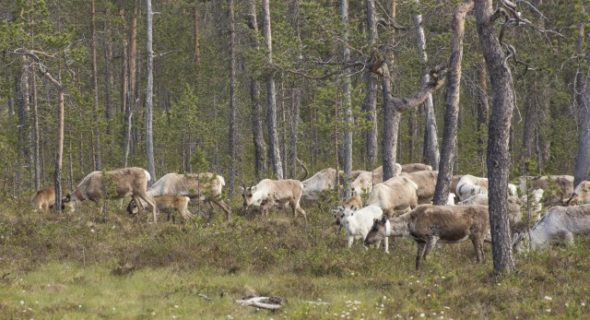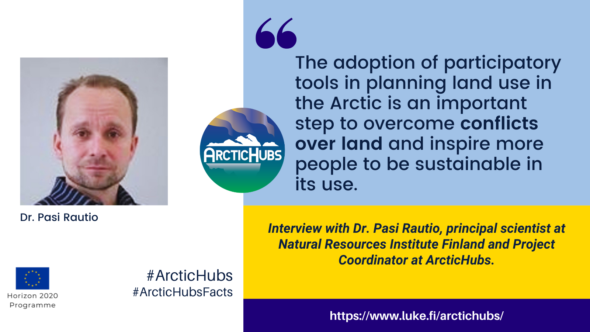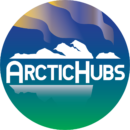Interview with Dr. Pasi Rautio, principal scientist at Natural Resources Institute Finland and Project Coordinator at ArcticHubs.
 As project coordinator of the ArcticHubs, Dr. Pasi Rautio hopes to contribute with his knowledge about natural research, forestry and environmental issues to ensure that the future (exploitation) of Arctic lands, and the competition of the different sectors on it, is more sustainable.
As project coordinator of the ArcticHubs, Dr. Pasi Rautio hopes to contribute with his knowledge about natural research, forestry and environmental issues to ensure that the future (exploitation) of Arctic lands, and the competition of the different sectors on it, is more sustainable.
In this interview we discuss how he became involved in the investigation of Arctic land use conflicts. Notably Dr. Rautio mentions how one of the biggest challenges for local communities is how they can become more resilient and adapt existing or traditional livelihoods to the changes that are occurring in the region. He also stresses that the adoption and use of participatory tools in planning land use (those tested and developed during the project) is an important step to overcome conflicts over land use and inspire more people to be sustainable in its use.
How did your professional journey through research in the Arctic begin?
I worked in a research group as a research assistant doing some lab work for a project investigating the effects of environmental pollution in the Kola Peninsula, Russia, and how that affected Finnish Lapland. Later that project developed to become the basis for my PhD-thesis.
Do you remember the first time you directly came across Arctic land-use conflict issues?
The first time was when I was representing the Finnish Forest Research Institute (nowadays Natural Resources Institute Finland, Luke) in early 2000’s, at some international bodies of the Arctic Monitoring and Assessment Programme (AMAP). During that time, I noticed the international tension that comes from e.g. the rights to natural resources in the Arctic.

Can you tell us what captured your attention regarding the land conflict and how this has impacted your research work subsequently?
The first time the land use conflict issues ended up on my table was when I came to work in Rovaniemi, for the Natural Resources Institute Finland, Luke. Once there I heard in closer detail about the conflicts between forestry management, reindeer herding and tourism activities. And later on, also mining activities were added on this long list of competitors for the Arctic land.
How did the idea of the ArcticHubs project come about? And the AH Consortium?
Basically it is a combination of two earlier Consortium and two separate projects. I did a couple of grant applications with the Luleå University of Technology (LTU) and the Swedish University of Agriculture (SLU) connected to the testing and developing of new type of an autonomous forestry machine that would allow more precise forestry operations – and hence could help to alleviate some land use conflicts with other sectors (e.g. tourism, reindeer herding). At the same time, my collegues Dr. Seija Tuulentie and Dr. Ari Nikula were finishing a research project funded by Northern Periphery & Arctic Programme, dealing with the sustainable use of natural resources in the Arctic.
We simply decided to combine these two research approaches and add some new components (like the public participatory GIS – PPGIS). The ArcticHubs Consortium partners are mostly drawn from these two earlier groupings.
Thinking beyond climate crisis per se, what is the biggest transformation that the Arctic has faced lately (or is facing)?
I think it is the increased international attention towards its region. And that raises partly from the fact that the huge potential in natural resources, including minerals and forest resources, have been noticed now.
Which skills do you think will be important in the future for the Arctic communities?
I know it is already a bit worn out statement, but I think resilient communities will survive best in coming changes. In the Arctic as well as elsewhere. Right now there is the need to change old methods of approaching livelihood opportunities. In so doing it may be possible to still continue engaging with those sectors even in changing Arctic conditions, perhaps alongside some new livelihoods.
Why are the activities of ArcticHubs project important for local communities and Arctic stakeholders?
I think the tools we are developing within the different project activities to reconcile land use conflicts, like the PPGIS (Public Participatory Geographic Information System) and SLO (Social Licence to Operate), can give local communities and Arctic stakeholders better ways to take part in the planning processes and when managing the land uses. For instance, during the planning processes these different tools (PPGIS or SLO) can be used also remotely. This provides opportunities for citizens to participate or express their position, even if they perhaps cannot or do not want to take part in a public hearing or planning workshops. Also the interactive components of some of these tools, like in the PPGIS, gives new possibilities to land use planners and local decision makers.

What expectations do you have for ArcticHubs?
I’m enthusiastic about the tools that we are testing to reconcile land use conflicts. If we manage to have those currently in use among Arctic communities and potential stakeholders when planning their activities in the different sectors, then we have achieved something that is really worth to work for:
A more participatory process to collect all the necessary data useful for planning any land use, should bring together all relevant people within private organizations / institutions, communities and public institutions. This approach will certainly stimulate reconciliation and discussions on how to incorporate more bottom-up planning for the future of the Arctic land.
Biography
Dr. Pasi Rautio is adjunct professor in plant and environmental ecology and he currently works as a principal scientist at the Natural Resources Institute Finland (Luke). His previous work at the University of Oulu in Finland and Stockholm University in Sweden has concerned issues like biodiversity and restoration of seminatural pastures; evolutionary ecology of plant-animal interactions and air pollution effects on forest ecosystems. He has worked also as a forest policy officer for the European Commission (DG Environment).
In his current research work for Luke he studies forest regeneration methods in areas that are facing the pressures of land uses, such as uses for tourism and reindeer herding. His other research interests include e.g. how climate changes induce changes in snowpack and can affect boreal forests. He is also a member of UNECE forest monitoring programme (ICP Forests) and contributed to the latest AACA-report (Adaptation Actions for a Changing Arctic).
